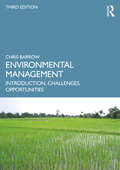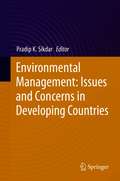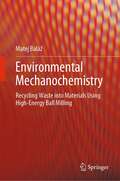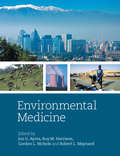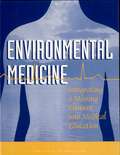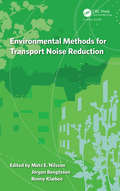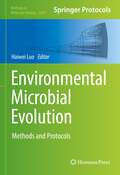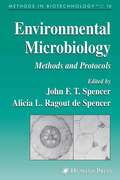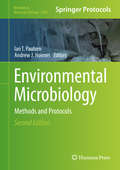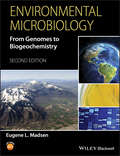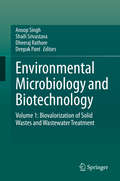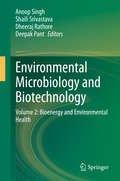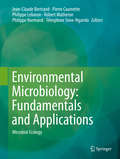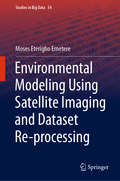- Table View
- List View
Environmental Management: Environmental Issues, Awareness and Abatement
by Basharat Mushtaq Suhaib A. Bandh Sana ShafiIn the current age of science and technology, our lives have become dominated by countless scientific and technological innovations without which the earth would be a much poorer place. Life as we know would become absolutely bleak and boring without the inventions and advances being made all over the globe. In fact, scientific inventions, discoveries and innovations have ushered in a dramatic revolution in virtually every sphere of life. But at the same time, the skewed use of technology is at loggerheads with the environment. We, and our environment, now face a number of critical challenges and it is in response to this that we wrote this book to raise awareness for environmental issues and related management aspects. With a primary focus on Environmental Management – the rational reconciliation of man and nature, which involves the judicious exploitation and utilization of natural resources without disturbing the ecosystem’s balance – it will thus help to improve the relationship between man and environment. Moreover, it offers a wealth of ready-to-use material for advanced undergraduate and graduate students of Environment and Water Management. The book systematically addresses a range of key aspects, e.g. scientific principles, methods and ideas, as well as life-long learning skills for students. Further, it provides a solid foundation for applying scientific approaches to environmental problems.
Environmental Management: Introduction, Challenges, Opportunities (Routledge Perspectives On Development Ser.)
by Chris BarrowThis comprehensively updated third edition explores the nature and role of environmental management and offers an introduction to this rapidly expanding and changing field. It focuses on challenges and opportunities, and core concepts including sustainable development. The book is divided into five parts: Part I (Introduction to Environmental Management): four introductory chapters cover the justification for environmental management, its theory, scope, goals and scientific background Part II (Practice): explores environmental management in economics, law and business and environmental management’s relation with environmentalism, international agreements and monitoring Part III (Global Challenges and Opportunities): examines resources, challenges and opportunities, both natural and human-caused or human-aggravated Part IV (Responses to Global Challenges and Opportunities): explores mitigation, vulnerability, resilience, adaptation and how technology, social change and politics affect responses to challenges Part V (The Future): the final chapter considers the way ahead for environmental management in the future. With its well-structured coverage, effective illustrations and foundation for further, more-focused interest, this book is easily accessible to all.It is an essential reference for undergraduates and postgraduates studying environmental management and sustainability, and an important resource for many students on courses including environmental science, environmental studies and human geography.
Environmental Management: Issues and Concerns in Developing Countries
by Pradip K. SikdarThis book deals with issues and concerns for the human environment in the developing countries incorporating natural processes and systems, pollution removal technology, energy conservation, environmental impact assessment process, economics, culture, political structure and societal equity from a management point of view. Solutions to the emerging problems of the environment need a paradigmatic shift in approach from a process based model to a socio-political-economic model. Hence environmental management should involve equality and control over use of the finite natural resources and the balance between Earth’s biocapacity and humanity’s ecological footprint. Changes such as green technologies, human population stabilization and adoption of ecologically harmonious lifestyles are absolutely essential and will require redesigning of political institutions, policies and revisiting forgotten skills of sustainable practices of environmental management. These challenges should centre on environment governance using the concepts of common property, equity and security.This book is relevant for academics, professionals, administrators and policy makers who are concerned with various aspects of environment management and governance.
Environmental Management: Problems and Solutions
by Louis Theodore R. Ryan Dupont Terry E. BaxterThere is a growing need to support undergraduate educators in the development of environmental management educational materials. Recognizing this need, the National Science Foundation funded a College Faculty Workshop on Environmental Management, that was conducted at Utah State University in July and August 1996. The principle objectives of the seminar were (1) to provide a meaningful course which would generate new ideas and innovative educational approaches in the emerging field of environmental management, and (2) to develop an applications-oriented problem workbook which would support undergraduate faculty involvement in the production of course materials. The result of this effort is Environmental Management: Problems and Solutions, an informative text on the essentials of environmental management.More than 200 structured problems presented in the book are meant to elicit a sound understanding of the basics of environmental monitoring, assessment and control. Detailed solutions to each problem, provided with each chapter, will prove useful to both the student and the instructor.This innovative text is a valuable resource for anyone involved in training of engineers and scientists in the field of environmental engineering.
Environmental Mechanochemistry: Recycling Waste into Materials using High-Energy Ball Milling
by Matej BalážThis book provides a comprehensive overview on mechanochemistry including its history, high-energy ball milling process, equipment used and fundamentals behind the observed scientific phenomena. It also shows that mechanochemistry is highly applicable in the field of waste treatment. The text reviews 1017 studies utilizing mostly high-energy ball milling for the treatment of various types of consumer, technogenic and agricultural waste. The text is divided into chapters based on individual waste types. The book presents an Appendix compiling all studies arranged according to the application that the recycled waste is meant for. In this way, readers from both academia and companies interested either in the treatment of a particular waste, or particular application might easily locate sections of interest.
Environmental Medicine
by Jon Ayres Roy Harrison Gordon Nichols Robert Maynard CBEEnvironmental Medicine is an indispensable aid to the investigation, diagnosis and treatment of a wide variety of environmentally-acquired disorders. It brings into sharp focus the increasing importance of the practice of environmental medicine, drawing together the many different strands that make up this modern discipline, and putting topical and
Environmental Medicine: Integrating a Missing Element into Medical Education
by Committee on Curriculum Development in Environmental MedicinePeople are increasingly concerned about potential environmental health hazards and often ask their physicians questions such as: "Is the tap water safe to drink?" "Is it safe to live near power lines?" Unfortunately, physicians often lack the information and training related to environmental health risks needed to answer such questions. This book discusses six competency based learning objectives for all medical school students, discusses the relevance of environmental health to specific courses and clerkships, and demonstrates how to integrate environmental health into the curriculum through published case studies, some of which are included in one of the book's three appendices. Also included is a guide on where to obtain additional information for treatment, referral, and follow-up for diseases with possible environmental and/or occupational origins.
Environmental Methods for Transport Noise Reduction
by Jörgen Bengtsson Mats E. Nilsson Ronny KlæboePresents Evidence-Based Guidance on Noise Abatement MethodsSolutions for reducing the noise impact of road and rail traffic can be found in the use of natural elements in combination with artificial elements in urban and rural environments. Ground and road surface treatments; trees, forests, and tall vegetation; and the greening of buildings and ot
Environmental Microbial Biotechnology
by Lala Behari Sukla Nilotpala Pradhan Sandeep Panda Barada Kanta MishraThis book provides a timely review of strategies for coping with polluted ecosystems by employing bacteria, fungi and algae. It presents the vast variety of microbial technologies currently applied in the bioremediation of a variety of anthropogenic toxic chemicals, mining and industrial wastes and other pollutants. Topics covered include: microbe-mineral interactions, biosensors in environmental monitoring, iron-mineral transformation, microbial biosurfactants, bioconversion of cotton gin waste to bioethanol, anaerobe bioleaching and sulfide oxidation. Further chapters discuss the effects of pollution on microbial diversity, as well as the role of microbes in the bioremediation of abandoned mining areas, industrial and horticultural wastes, wastewater and sites polluted with hydrocarbons, heavy metals, manganese and uranium.
Environmental Microbial Evolution: Methods and Protocols (Methods in Molecular Biology #2569)
by Haiwei LuoThis volume explores the latest techniques used to study environmental microbial evolution, with a focus on methods capable of addressing deep evolution at long timescales. The chapters in this book are organized into three parts. Part One introduces molecular dating approaches and time calibration ideas that allow for the determination of evolutionary timescales of microbial lineages. Part Two describes several advanced phylogenomic tools such as models for genome tree construction, a taxon sampling method, outgroup-independent tree-rooting methods, and gene family evolution models. Part Three covers techniques used to study trait evolution. Written in the highly successful Methods in Molecular Biology series format, chapters include introductions to their respective topics, lists of the necessary materials and reagents, step-by-step, readily reproducible laboratory protocols, and tips on troubleshooting and avoiding known pitfalls.Cutting-edge and comprehensive, Environmental Microbial Evolution: Methods and Protocols is a valuable tool for all researchers who are interested in learning more about this important and evolving field.
Environmental Microbiology
by Alan Varnam Malcolm EvansMicro-organisms play a major role in the geochemistry of the planet, forming the basic stage in the food chain, and thus sustaining the existence of higher evolutionary life. The continuing interaction between these living organisms and the environment, combined with their exploitation by man are shaping the material world today.Over the last few y
Environmental Microbiology
by John F. Spencer Alicia L. Ragout de SpencerA collection of readily reproducible techniques for determining most of the important factors governing microorganisms and their habitats. Presented in step-by-step detail, these cutting-edge methods range from those for the study of marine organisms, to those for investigating microorganisms occurring in groundwater, to the biodiversity of yeasts found in remote environments. The novel protocols for studying fermented milks are significant for investigators concerned with milk as an item of food for infants, small children, and even adults. Additional methods for the recovery and determination of nucleic acids and other compounds affecting, and affected by, microorganisms are given for certain enzymes produced by plant pathogens and for obtaining microbial species tolerant of such inhibitors as heavy metals.
Environmental Microbiology
by Ian T. Paulsen Andrew J. HolmesAn up-to-date view of molecular mechanisms for investigating microbial communities and their biological activities, this new volume of "Environmental Microbiology: Methods and Protocols" looks at recent advances that are having a big impact on the field such as metagenomics and other "omics" technologies, NanoSIMS, as well as stable isotope probing and more. Conveniently divided into four parts, the first section looks at methods involved in sampling environmental microorganisms, the second profiles different methods for investigating the diversity and composition of microbial communities, the third focuses on techniques for analyzing biological activities "in situ," and the final section examines high throughput "omics" approaches for the characterization of environmental microbial communities. This book was written as part of the highly successful "Methods in Molecular Biology" series, and, as such, chapters contain introductions to their respective topics, lists of the necessary materials and reagents, step-by-step, readily reproducible laboratory protocols, and tips on troubleshooting and avoiding known pitfalls. Fully updated and authoritative, "Environmental Microbiology: Methods and Protocols, Second Edition" aims to provide an unprecedented glimpse into the structure, composition, and activity of microbial communities across diverse environments and illuminate their impact on global ecological processes.
Environmental Microbiology
by Eugene L. MadsenThis well-referenced, inquiry-driven text presents an up-to-date and comprehensive understanding of the emerging field of environmental microbiology. Coherent and comprehensive treatment of the dynamic, emerging field of environmental microbiology Emphasis on real-world habitats and selective pressures experienced by naturally occurring microorganisms Case studies and "Science and the Citizen" features relate issues in the public's mind to the underlying science Unique emphasis on current methodologies and strategies for conducting environmental microbiological research, including methods, logic, and data interpretation
Environmental Microbiology
by Walter Reineke Michael SchlömannThis textbook addresses global and local environmental problems and the involvement of microorganisms in their development and remediation. In particular, methodological aspects, some of them molecular genetic, for the study of microbial communities are considered. Overall, the prominent role of microorganisms in various material cycles is presented. In addition to biochemical principles for the degradation of environmental pollutants, the use of microorganisms in environmental biotechnological processes for the purification of air, water or soil as well as in environmentally friendly production processes is discussed. The book is intended for biologists with an interest in environmental microbiological issues, but also for students of process or environmental engineering, geoecology or geology, as well as students of other environmental science disciplines. For the 3rd edition, the authors have completely revised, corrected, updated and supplemented the book.
Environmental Microbiology and Biotechnology: Volume 1: Biovalorization of Solid Wastes and Wastewater Treatment
by Anoop Singh Dheeraj Rathore Deepak Pant Shaili SrivastavaThis book provides up-to-date information on the state of the art in applications of biotechnological and microbiological tools for protecting the environment. Written by leading international experts, it discusses potential applications of biotechnological and microbiological techniques in solid waste management, wastewater treatment, agriculture, energy and environmental health. This first volume of the book “Environmental Microbiology and Biotechnology,” covers three main topics: Solid waste management, Agriculture utilization and Water treatment technology, exploring the latest developments from around the globe regarding applications of biotechnology and microbiology for converting wastes into valuable products and at the same time reducing the environmental pollution resulting from disposal. Wherever possible it also includes real-world examples. Further, it offers advice on which procedures should be followed to achieve satisfactory results, and provides insights that will promote the transition to the sustainable utilization of various waste products.
Environmental Microbiology and Biotechnology: Volume 2: Bioenergy and Environmental Health
by Anoop Singh Dheeraj Rathore Deepak Pant Shaili SrivastavaThis book provides up-to-date information on the state of the art in applications of biotechnological and microbiological tools for protecting the environment. Written by leading international experts, it discusses potential applications of biotechnological and microbiological techniques in solid waste management, wastewater treatment, agriculture, energy and environmental health. This second volume of book “Environmental Microbiology and Biotechnology,” covers two main topics: bioenergy and environmental health, exploring the latest developments from around the globe regarding applications of biotechnology and microbiology for converting wastes into valuable products and at the same time reducing the environmental pollution resulting from disposal. Wherever possible it also includes real-world examples. Further, it offers advice on which procedures should be followed to achieve satisfactory results, and provides insights that will promote the transition to the sustainable utilization of various waste products.
Environmental Microbiology and Microbial Ecology
by Larry L. Barton Robert J. McLeanAn authoritative overview of the ecological activities of microbes in the biosphere Environmental Microbiology and Microbial Ecology presents a broad overview of microbial activity and microbes' interactions with their environments and communities. Adopting an integrative approach, this text covers both conventional ecological issues as well as cross-disciplinary investigations that combine facets of microbiology, ecology, environmental science and engineering, molecular biology, and biochemistry. Focusing primarily on single-cell forms of prokaryotes — and cellular forms of algae, fungi, and protozoans — this book enables readers to gain insight into the fundamental methodologies for the characterization of microorganisms in the biosphere. The authors draw from decades of experience to examine the environmental processes mediated by microorganisms and explore the interactions between microorganisms and higher life forms. Highly relevant to modern readers, this book examines topics including the ecology of microorganisms in engineered environments, microbial phylogeny and interactions, microbial processes in relation to environmental pollution, and many more. Now in its second edition, this book features updated references and major revisions to chapters on assessing microbial communities, community relationships, and their global impact. New content such as effective public communication of research findings and advice on scientific article review equips readers with practical real-world skills. Explores the activities of microorganisms in specific environments with case studies and actual research data Highlights how prominent microbial biologists address significant microbial ecology issues Offers guidance on scientific communication, including scientific presentations and grant preparation Includes plentiful illustrations and examples of microbial interactions, community structures, and human-bacterial connections Provides chapter summaries, review questions, selected reading lists, a complete glossary, and critical thinking exercises Environmental Microbiology and Microbial Ecology is an ideal textbook for graduate and advanced undergraduate courses in biology, microbiology, ecology, and environmental science, while also serving as a current and informative reference for microbiologists, cell and molecular biologists, ecologists, and environmental professionals.
Environmental Microbiology for Engineers
by Volodymyr IvanovUpdated Edition Includes a New Chapter and Enhanced Study MaterialThe second edition of Environmental Microbiology for Engineers explores the role that microorganisms play in the engineered protection and enhancement of an environment. Offering a perfect balance of microbiological knowledge and environmental biotechnology principles, it provides a
Environmental Microbiology for Engineers
by Volodymyr IvanovThe third edition of Environmental Microbiology for Engineers explores the role that microorganisms play in the engineered protection and enhancement of an environment. Offering a perfect balance of microbiological knowledge and environmental biotechnology principles, it provides a practical understanding of microorganisms and their functions in the environment and in environmental engineering systems. The book also presents a quantitative description of applied microbiological processes and their engineering design. This updated edition includes all new information on construction biotechnology, biogeotechnical engineering, construction biomaterials, environmental engineering of life-support closed ecosystems, defense biotechnologies, and biosafety in civil and environmental engineering. Features: Classroom tested in universities as a primary course text for civil and environmental engineering students Includes quizzes, problems, and solutions for better understanding of the material Covers essential topics such as the diversity and functions of microorganisms in the environment and environmental engineering systems, the structure and functions of microbial ecosystems, applied microbial genetics and molecular biology, environmental bioengineering, and more Offers combined coverage of microbiology and biotechnology adapted for students in advanced civil and environmental engineering courses Environmental Microbiology for Engineers provides a practical understanding of microorganisms in civil engineering processes and their functions in environmental engineering systems. It is intended for upper-level undergraduate, graduate, and post-graduate students of civil and environmental engineering. It is also useful for practicing environmental engineers working in the areas of wastewater, solid waste treatment, soil remediation, and ground improvement.
Environmental Microbiology of Aquatic and Waste Systems
by Nduka OkaforThis book places the main actors in environmental microbiology, namely the microorganisms, on center stage. Using the modern approach of 16S ribosomal RNA, the book looks at the taxonomy of marine and freshwater bacteria, fungi, protozoa, algae, viruses, and the smaller aquatic animals such as nematodes and rotifers, as well as at the study of unculturable aquatic microorganisms (metagenomics). The peculiarities of water as an environment for microbial growth, and the influence of aquatic microorganisms on global climate and global recycling of nitrogen and sulphur are also examined. The pollution of water is explored in the context of self-purification of natural waters. Modern municipal water purification and disease transmission through water are discussed. Alternative methods for solid waste disposal are related to the economic capability of a society. Viruses are given special attention. By focusing on the basics, this primer will appeal across a wide range of disciplines.
Environmental Microbiology: From Genomes to Biogeochemistry
by Eugene L. MadsenThis well-referenced, inquiry-driven text presents an up-to-date and comprehensive understanding of the emerging field of environmental microbiology. Coherent and comprehensive treatment of the dynamic, emerging field of environmental microbiology Emphasis on real-world habitats and selective pressures experienced by naturally occurring microorganisms Case studies and “Science and the Citizen” features relate issues in the public’s mind to the underlying science Unique emphasis on current methodologies and strategies for conducting environmental microbiological research, including methods, logic, and data interpretation
Environmental Microbiology: Fundamentals and Applications
by Jean-Claude Bertrand Pierre Caumette Philippe Lebaron Robert Matheron Philippe Normand Télesphore Sime-NgandoThis book is a treatise on microbial ecology that covers traditional and cutting-edge issues in the ecology of microbes in the biosphere. It emphasizes on study tools, microbial taxonomy and the fundamentals of microbial activities and interactions within their communities and environment as well as on the related food web dynamics and biogeochemical cycling. The work exceeds the traditional domain of microbial ecology by revisiting the evolution of cellular prokaryotes and eukaryotes and stressing the general principles of ecology. The overview of the topics, authored by more than 80 specialists, is one of the broadest in the field of environmental microbiology. The overview of the topics, authored by more than 80 specialists, is one of the broadest in the field of environmental microbiology.
Environmental Modeling Using Satellite Imaging and Dataset Re-processing (Studies in Big Data #54)
by Moses Eterigho EmetereThis book introduces methods of re-processing images to extract numerical information that can be used to quantify the observables in environmental modelling. Experiments or procedures that yield large images can be statistically or parametrically examined. Through the use of open source libraries, the book shows how ‘big data’ in the form of images or datasets can be comparatively analysed along same defined procedures or standards. This book helps to solve the challenges of discarding datasets that are relevant directly or indirectly to the research. The habit of screening datasets leads to the discard of over 90% of the original dataset or images generated in the experiments or procedure. If the images or datasets are generated under the same principles or conditions, then each measurement may be the narrative of unique events. The focus of this book is to enlighten researchers on how to analyse measurements with the aim of ensuring 100% utilization.
Environmental Modeling and Health Risk Analysis (Acts/Risk)
by Mustafa M. AralThis book is intended to serve as a comprehensive source for the advancements and contributions made in environmental transformation and transport modeling in general and the associated health risk assessment topics in particular. The selection of the title, "Environmental Modeling and Health Risk Analysis" stems from an ambitious objective of providing a review of air, surface water and groundwater quality modeling topics and linking these models with exposure and health risk analysis. Thus, the purpose is to provide the reader with an integrated perspective on these two seemingly distant fields. The ACTS and RISK software that is an integral part of this book include computational platforms for all models discussed in the book. Using these two software tools, available from http://extras.springer.com/ , the models described in the book can be readily accessed and used in classroom or professional applications as demonstrated in the book.

